Does your small business have a customer service problem? Too often, business owners or managers recognize they have a service issue, yet their efforts to address shortcomings fail to solve the problem. In the worst cases, customer service initiatives backfire and motivate people to do less.
So, what’s going on? Usually a few things. Typically, there’s an organizational mindset misalignment, a lack of commitment from business owners or managers, an absence of recognition for giving great service, or a combination of all three.
SERVICE MINDSET
Great service companies have a service mindset and commitment, and they reward great performance. From the top down, management and workers eat, sleep, and breathe extraordinary service.
They have a service mission, and it does more than sit in a frame on a wall in some conference room. It’s top of mind throughout the organization. People know it and live it through their daily interactions with customers and each other.
These companies design processes with the customer’s best interest in mind. Think about that well-known airline that’s so full of love for its customers it allows them to cancel flights for full credit on a future trip. Clearly they believe most of their customers won’t book travel they don’t need, and those who must make a change will eventually choose to fly with them again.
The airline hires people who genuinely love service and are proud to live the brand. They constantly retool the customer experience because they know what worked well in earlier years is long overdue for a makeover. They educate, educate, and then they educate some more. They want to make sure that the people who represent the brand understand what the brand experience is and how to deliver it.
EDUCATION IS KEY
Great service companies involve everyone in their service culture and improvement efforts. They invest in their employees and trust them to do what’s right. Their management team models service-centric behavior and holds others accountable for doing the same. Their leaders participate in education efforts, often introducing workshops, wrapping them up, and actively taking part during sessions.
These companies commit to and believe in their staff. Because they’ve chosen their employees well and trained them appropriately, they treat staff members as the adults they are and give them latitude when solving service problems.
Great service companies reward service-centric behavior. They don’t ignore great work or punish people for taking initiative. They value their employees and recognize that without them, there is no customer service. They reward employees by trusting them to do what’s right. They encourage people to find new ways of solving problems. They recognize that a paycheck alone is not enough.
When thinking about everything that the greats do, it’s easy to get discouraged or think your business or department will never achieve true service success. The good news is you’re wrong. While it won’t happen overnight, you can take a page or two from the masters to elevate your approach.
JUMP RIGHT IN
What do you do when you realize you’re not so great? Start fixing the problem with these seven steps:
Start by thinking about your purpose. What is it that your organization does? Articulate your purpose. Everyone needs to understand your core reason for existing and how the actions they take related to service support that mission.
Next, think about your processes and how customers interact with you. Do you have your customers’ best interests at heart? If not, what changes can you make to remedy those shortcomings? When your company and customer goals are in harmony, you will have happier customers. Furthermore, it is less likely your people will find themselves dealing with the unhappy, disappointed, or disgruntled.
Model what you want to see. People work for people. If you supervise others, they are watching and learning from you. If you are disengaged, they probably are too. On the other hand, if you embody the spirit of service, you probably see elements of yourself in their performance.
Teach your staff what to do and how to do it. You can’t expect people to deliver great service if they don’t know how. Furthermore, you can’t expect them to care if no one at the top does. Take employee development seriously. This means being a champion for training, participating in education, and coaching for new skills after the fact. Eventually, your people will be able to do more, make better choices, and solve problems more imaginatively.
Hire for service skills. The next time you have an opening, think about what makes someone great at service in your company and seek those attributes. Don’t settle. You’ll be sorry later.
Reward. Even if you have no budget, you can reward employees for giving great service. Start with a sincere thank you. Heartfelt appreciation can work wonders.
Finally, put your continuous-improvement hat on. Systematically evaluate where you’ve been, where you are, and where you are going.
GETTING STARTED
None of these steps are necessarily hard. The trick is to take them. In other words, to win the service game, you’ve got to be in it. What will you do better today?
Kate Zabriskie develops customer service strategies and training programs as president of Maryland-based Business Training Works. For more information, visit www.businesstrainingworks.com.





